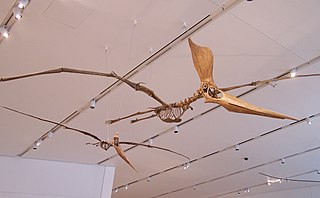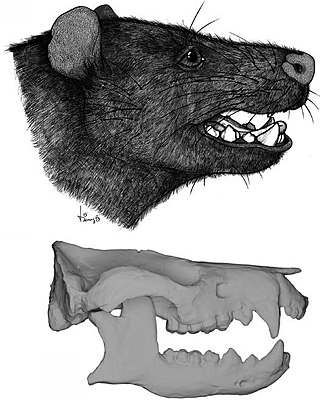Gondwanatherium is a genus of stem-mammal from the extinct suborder Gondwanatheria that lived in Patagonia, South America during the "Age of Dinosaurs", specifically during the Late Cretaceous.

Orthoceras is a genus of extinct nautiloid cephalopod restricted to Middle Ordovician-aged marine limestones of the Baltic States and Sweden. This genus is sometimes called Orthoceratites. Note it is sometimes misspelled as Orthocera, Orthocerus or Orthoceros.
Professor David Bruce Weishampel is an American palaeontologist in the Center for Functional Anatomy and Evolution at Johns Hopkins University School of Medicine. Weishampel received his Ph.D. in Geology from the University of Pennsylvania in 1981. His research focuses include dinosaur systematics, European dinosaurs of the Late Cretaceous, jaw mechanics and herbivory, cladistics and heterochrony and the history of evolutionary biology. Weishampel's best known published work is The Dinosauria University of California Press; 2nd edition. He consulted for Jurassic Park and is a good friend of Steven Spielberg. He has received an Academy Scientific and Technical Award.

Ichthyornithes is an extinct group of toothed avialans very closely related to the common ancestor of all modern birds. They are known from fossil remains found throughout the late Cretaceous period of North America, though only two genera, Ichthyornis and Janavis, are represented by complete enough fossils to have been named. Ichthyornitheans became extinct at the Cretaceous–Paleogene boundary, along with enantiornitheans, all other non-avian dinosaurs, and many other animal and plant groups.

The Pteranodontidae are a family of large pterosaurs of the Cretaceous Period of North America and Africa. The family was named in 1876 by Othniel Charles Marsh. Pteranodontids had a distinctive, elongated crest jutting from the rear of the head. The spectacularly-crested Nyctosaurus is sometimes included in this family, though usually placed in its own family, the Nyctosauridae.
Platypterygius is a historically paraphyletic genus of platypterygiine ichthyosaur from the Cretaceous period. It was historically used as a wastebasket taxon, and most species within Platypterygius likely are undiagnostic at the genus or species level, or represent distinct genera, even being argued as invalid. While fossils referred to Platypterygius have been found throughout different continents, the holotype specimen was found in Germany.
Apsaravis is a Mesozoic bird genus from the Late Cretaceous. The single known species, Apsaravis ukhaana, lived about 78 million years ago, in the Campanian age of the Cretaceous period. Its fossilized remains were found in the Camel's Humps sublocality of the Djadokhta Formation, at Ukhaa Tolgod in the Gobi Desert of Mongolia. They were collected in the 1998 field season by the Mongolian Academy of Sciences/American Museum of Natural History Paleontological Expeditions. It was described by Norell and Clarke (2001).
Pasquiaornis is a prehistoric flightless bird genus from the Late Cretaceous. It lived during the late Cenomanian, between 95 and 93 million years ago in North America.

Toxochelys is an extinct genus of marine turtle from the Late Cretaceous period. It is the most commonly found fossilized turtle species in the Smoky Hill Chalk, in western Kansas.

Ophthalmosauridae is an extinct family of thunnosaur ichthyosaurs from the Middle Jurassic to the early Late Cretaceous worldwide. Almost all ichthyosaurs from the Middle Jurassic onwards belong to the family, until the extinction of ichthyosaurs in the early Late Cretaceous. Opthalmosaurids appeared worldwide during early Bajocian, subsequent to the disappearance of most other ichthyosaur lineages after the end of the Toarcian. Currently, the oldest known ophthalmosaurids is Mollesaurus from the early Bajocian of Argentina, as well as indeterminate remains of the same age from Luxembourg and Canada. Named by George H. Baur, in 1887, the family contains the basal taxa like Ophthalmosaurus. Appleby (1956) named the taxon Ophthalmosauria which was followed by some authors, but these two names are often treated as synonyms; Ophthalmosauridae has the priority over Ophthalmosauria. However, some researchers argue that Ophthalmosauridae should be restricted to the group typically referred to as Ophthalmosaurinae, with classic Platypterygiinae instead being referred to as Undorosauridae or Brachypterygiidae and Ophthalmosauria being used to unite these two groups.

Atoposauridae is a family of crocodile-line archosaurs belonging to Neosuchia. The majority of the family are known from Late Jurassic to Early Cretaceous marine deposits in France, Portugal, and Bavaria in southern Germany. The discovery of the genus Aprosuchus, however, extends the duration of the lineage to the end of the Cretaceous in Romania.

Peligrotherium is an extinct meridiolestidan, and the sole member of the family Peligrotheriidae, from the Paleocene of Patagonia, originally interpreted as a stem-ungulate. Its remains have been found in the Salamanca Formation. It was a dog-sized mammal, among the largest of all dryolestoids, and closely related to mesungulatids, another lineage of large sized herbivorous dryolestoids. A recent phylogenetic study finds it to be the sister taxon to Reigitherium.

Pholidosauridae is an extinct family of aquatic neosuchian mesoeucrocodylian crocodylomorphs. Fossils have been found in Europe, Africa, North America and South America. The pholidosaurids first appeared in the fossil record during the Bathonian stage of the Middle Jurassic. Jouve & Jalil (2020) described postcranial material of a pholidosaurid from the Paleocene (Danian) of Ouled Abdoun Basin (Morocco), representing the most recent record of the family. The authors also reinterpreted putative Maastrichtian dyrosaurid Sabinosuchus as a pholidosaurid, and argued that at least two independent pholidosaurid lineages reached the Maastrichtian, among which one survived the Cretaceous–Paleogene extinction event. Before the publication of this study it was thought that the family became extinct during the Late Turonian stage of the Late Cretaceous.
Aetodactylus is a genus of targaryendraconian pterosaur. It is known from a lower jaw discovered in Upper Cretaceous rocks of northeastern Texas, United States.
Brodavis is a genus of freshwater hesperornithiform birds known from the Late Cretaceous of North America and Asia. It was first described and named by Larry D. Martin, Evgeny N. Kurochkin and Tim T. Tokaryk in 2012 and assigned to a new monogeneric family, Brodavidae. Four species were described and assigned to Brodavis.

Deltatheridiidae is an extinct family of basal carnivorous metatherians that lived in the Cretaceous and were closely related to marsupials. Their fossils are restricted to Central Asia and North America. They mostly disappeared in the KT event, but a ghost lineage, currently represented by Gurbanodelta, survived until the late Paleocene by decreasing in size and becoming insectivorous.

Macrobaenidae is an extinct family of turtles, known from the Early Cretaceous to Paleogene of Laurasia. Their relationships to other turtles and whether or not they form a monophlyletic group are controversial. They are typically interpreted as stem or crown group cryptodires, but some more recent analyses have found them to lie outside crown group Testudines. Macrobaenids can be distinguished from other testudinatans by the presence of a carotid fenestra, cruciform plastron with strap-like epiplastra, and a lack of extragulars.

Targaryendraconia is an extinct clade of lanceodontian pterosaurs that lived from the Early to Late Cretaceous period in Europe, North America, South America, and Australia.

Ginglymodi is a clade of ray-finned fish containing modern-day gars (Lepisosteidae) and their extinct relatives, including the family Lepidotidae and the orders Semionotiformes and Kyphosichthyiformes, and various other extinct taxa. Ginglymodi is one of the two major subgroups of the infraclass Holostei, the other one being Halecomorphi, which contains the bowfin and its fossil relatives.
Ondogurvel is a genus of alvarezsaurid dinosaur from the Late Cretaceous (Campanian) Barun Goyot Formation in southern Mongolia. The type and only species is O. alifanovi, known from a partial skeleton consisting of fragments of two last dorsal vertebrae, three anterior sacral vertebrae, right ilium, left and right pubis and ischium, articulated right tibia, fibula, metatarsals II and IV, and phalanges IV-1 and IV-2, right carpometacarpus, left and right manual phalanx II-1, right femur, left pedal phalanx II-1, and fragments of unidentified phalanges.












